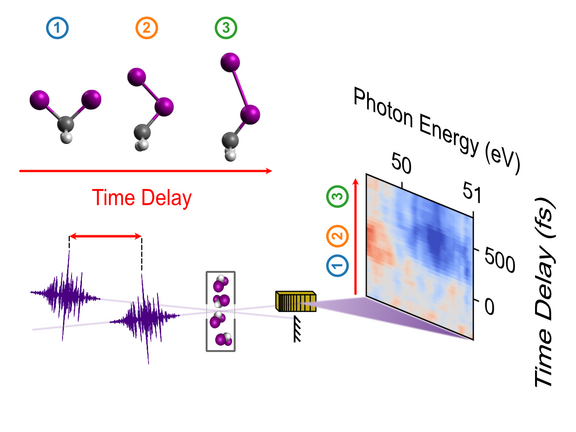The experiment was performed at the free-electron laser in Hamburg (FLASH), leading a large international collaboration of science teams. Two identical XUV pulses with a variable time delay interact subsequently with an iodine atom of CH2I2 (see Fig. 1). The excitation during the first pulse triggers the dissociation of the molecule, which includes a structural deformation through a short-lived isomeric state (see sketches ①②③). This, in turn, changes the XUV absorption behaviour of CH2I2. which can be analysed via time-dependent spectroscopy with the second XUV pulse. The change in the absorption signal (red: enhancement, blue: reduction) is clearly visible at a delay of about 200 femtoseconds (fs). This time-resolved information on the transition through the corresponding transient molecular structure ② was extracted by the comparison of experimental spectra with calculations in the theoretical chemistry group of Alexander Kuleff at the Institute of Physical Chemistry, Heidelberg University.
Overall, this is a key step towards using free-electron lasers for time-resolved measurements of moving atoms in molecules (the so-called “molecular movie”). In the future, even larger bandwidths and multi-colour modes will be available to excite and sample different electronic transitions with "local" atom-specific spectroscopic resolution. This also lights the way forward to ultimately control the molecular structure on the fundamental atomic and electronic level.
Original publication:
All-XUV pump-probe transient absorption spectroscopy of the structural molecular dynamics of di-iodomethane
Marc Rebholz, Thomas Ding, Victor Despré, Lennart Aufleger, Maximilian Hartmann, Kristina Meyer, Veit Stooß, Alexander Magunia, David Wachs, Paul Birk, Yonghao Mi, Gergana Dimitrova Borisova, Carina da Costa Castanheira, Patrick Rupprecht, Georg Schmid, Kirsten Schnorr, Claus Dieter Schröter, Robert Moshammer, Zhi-Heng Loh, Andrew R. Attar, Stephen R. Leone, Thomas Gaumnitz, Hans Jakob Wörner, Sebastian Roling, Marco Butz, Helmut Zacharias, Stefan Düsterer, Rolf Treusch, Günter Brenner, Jonas Vester, Alexander I. Kuleff, Christian Ott and Thomas Pfeifer
Phys. Rev. X 11, 031001 (2021). DOI: 10.1103/PhysRevX.11.031001
Further information:
Research Group “Excited Atoms and Molecules in Strong Fields”
Theoretical Chemistry Group (PCI Heidelberg University)
Free-electron laser FLASH (DESY)
Division “Quantum Dynamics & Control”
